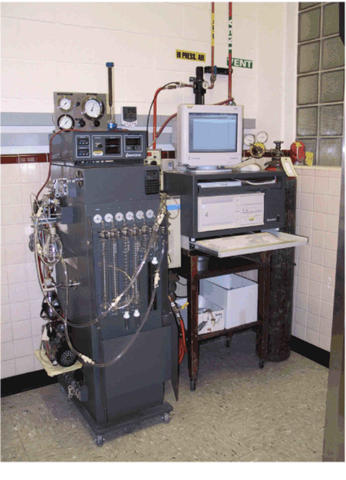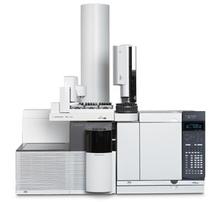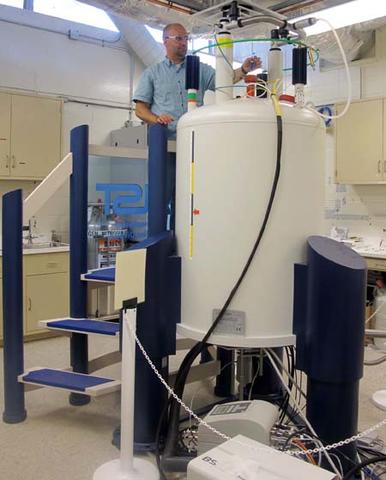Analytical Chemistry Laboratory
Summary
Performing world class research on the properties of fluids is impossible unless we can assure of the integrity of the fluids measured. One must not only ensure that the fluids one starts with are pure (or at least, within expectation), one must ensure that the measurement approaches that are applied do not change the fluids during a measurement. The only realistic way to approach this is to apply modern methods of chemical analysis in all phases of measurement. For this reason the Experimental Properties of Fluids Group provides chemical analysis and characterization facilities for the Applied Chemicals & Materials Division.
Analytical Gas Chromatography
Capabilities include capillary, packed column, and preparative scale chromatography using flame ionization, thermal conductivity density balance, ultrasonic, electron capture, infrared spectrophotometric and mass selective detection. Sample introduction methods (pressure programmable) include flash vaporization, split/splitless, autosampler, headspace analysis, cryofocus/cryotrap, purge/trap, and valve methods. Gaseous standard preparations are done using a gravimetric preparation facility located within the division. Twelve separate gas chromatographs provide: bulk and trace analysis of liquid and gaseous samples; as well as physicochemical chromatography. Provisions for sub-ambient temperature separations and sample handling are also available.

A preparative scale chromatography facility is provided in a dedicated laboratory that can be used for hazardous materials. The fully automated chromatograph is equipped with six fraction collectors, and can accommodate columns from 1 to 4 cm in diameter, and up to 1 m in length. This facility provides separation capacities of between 1 and 100 g per day, depending on the sample.
Mass Spectrometry
Two single quadrupole mass spectrometers provide mass resolution of 1 Dalton from 3 to 1500 RMM units, using quadrupolar mass filters, with sample introduction being done via capillary column gas chromatography or high vacuum direct insertion probe. The NIST-EPA mass spectral library and several NIST generated contaminant and compound specific libraries can be searched to provide qualitative analysis.
We have recently added the impressive capability of gas chromatography coupled with the tandem mass spectrometry approach. Our tandem quadrupole - time of flight (QTOF) instrument provides accurate mass determinations, and the isolation of parent ions and subsequent fragmentation provides identification (it will detect any daughter ion passed into the TOF).

Infrared Spectrophotometry
Four instruments cover the mid-infrared and near-infrared regions. An energy dispersive spectrophotometer is available for gaseous, liquid, supercritical fluid, and solid samples, covering the range of 4000 cm-1 to 600 cm-1. Temperature and pressure control of samples are also featured. Three Fourier Transform near-infrared spectrophotometers with quartz fiber optics cover the range from 0.8 µm to 2.5 µm. Attenuated total reflectance probes are also available.
Nuclear Magnetic Resonance Spectrometry
A 600 MHz NMR spectrometer is located within the Group. This instrument features a cryoprobe, a MAS solids probe, multinuclear probe, full temperature control, and a diffusion measurement capability.

Ultraviolet Spectrophotometry
Eight separate instruments provide spectrophotometry in the uv-vis region for liquid and supercritical fluid samples, with the capability of thermostatic control of cell compartment, and the availability of pressurized sample cells. One instrument provides the high resolution needed for frequency shift measurements.
Liquid Chromatography
A gradient elution instrument with diode array UV-vis, refractive index and fluorescence detection is available. Additional capability includes sub-ambient temperature sample introduction, autosampler, and a wide selection of column technology.
Luminescence
Two scanning spectrofluorometers, which operate in the UV-vis region, provide fluorescence spectra, and quantitation of fluorescent species to the 20 parts per trillion range. This instrument can also measure fluorescence spectra of samples at high pressures (up to 6000 psi).
Miscellaneous
Ultrasonic sample preparation; air-sensitive sample preparation; gravimetric gas standard preparation facility; microscopy; high temperature high pressure reaction screening facility; complete "wet" chemical analysis capability; lyophilization phase separation; pore size analyzer; headspace analysis; Karl Fischer moisture titrimetric instrumentation; refractometry; densimetry; monochromatic light scattering; and molecular polarizability. Much of the ancillary instrumentation and accessories have been developed within the Group. These capabilities include: chromatographic detectors, decomposition cells, sample concentrators, spectroscopic cells and headspace analysis devices.
Analytical Data Compilation

As part of our chemical analysis facility, we also maintain several databases of analytical chemistry data and information, made available primarily through the CRC Handbook of Basic Tables for Chemical Analysis, now in its third edition, and the CRC Handbook of Fundamental Spectroscopic Correlation Charts.
T.J. Bruno, Svoronos, P.D.N, 2011. CRC Handbook of Basic Tables for Chemical Analysis, Third Edition. CRC Taylor and Francis, Boca Raton.
T.J. Bruno, Svoronos, P.D.N., 2006. CRC Handbook of Fundamental Spectroscopic Correlation Charts. Taylor and Francis CRC Press, Boca Raton.

